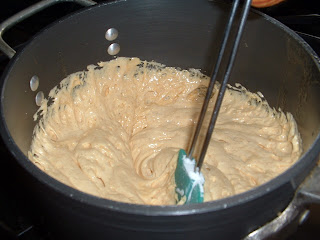

Others call it sea foam. Either way, it is a tasty little part of a nice assortment of Mignardises.
My son and I decided to use this experiment for a Science project of his as he needed to do something that can serve as a forum for questions, observations, theories, more observations and result driven findings. What better way to do this than with baking and pastry work I said? Is this not what we as chef's do all day long? I remembered the chemical reaction that occurs as you add the baking soda to the fast approaching caramel stage of the sugar when boiled. It was refreshing to see the results and record them meticulously as they happened, all with my 12 year old son. At first, he did not really embrace the whole concept, yet as we progressed, he became very excited and enthused with what was taking place right before his eyes. We took pictures along the way to show the stages of this little "after dessert" snack that not-so-many times we find in some of the nicer food emporiums. We used to serve this dipped in dark chocolate, which is probably the most typical for mignardises, but we have also used it crumbled up and sprinkled onto desserts, over ice creams and folded into mousses, and crusted onto foie gras, yet it has to be done ala minute as it tends to melt rather quickly when coming into contact with liquids. Fun to explore if nothing else. You can let your imagination run rampant with the possibilities.
The recipe is as follows:
1 cp. Granulated Sugar
1 cp. Light Corn Syrup
1 Tbl. Plain White Vinegar
1 Tbl. Baking Soda
A/N chocolate, or other ingredients to add to, dip in, fold into etc.
Method: Mix the sugar, corn syrup and vinegar into a clean large sauce pan, making sure that all is mixed evenly(first photo, top left). Bring to a boil. Cook gently, yet evenly without stirring. (second photo, top right is at 250 degrees-still clear and getting thicker) Cook to 300 degrees using a well calibrated candy thermometer(third photo, second below from top left) and remove from heat. Add baking soda all at once and stir quickly and thoroughly to absorb all of soda(fourth photo, second below from right). Note that it forms a thick, yellowing mass that is very creamy, to that of whipped cream. Pour immediately onto a lightly oiled pan(s) as it starts to set very rapidly(fifth photo, third below top left) and allow for expansion as the chemical reaction and gases are still being released as it is still cooking. It will continue to expand a bit, but after 5 minutes or so, it will receded about 10%. After 10 minutes, it will be cool enough to handle and break into pieces(last photo) and is able to be used as desired. Note the very airy inner texture; hence sponge candy. You can obtain a finer "mesh" by mixing the whole mass more so before pouring into pans, thus breaking down the structure a bit more.












2 Comments:
Isn't this why why cook? Modern day alchemists? I used baking a cake to demo the use of gas, and mayo to demo emulsification of 2 dissimilar ingredients to make one.
I was taking foods 4th period and chemistry 5th. I like this one. Cheers!
Great! Thanks. It is a fun experience. Dipped in chocolate, it is a nice dessert snack as well.
Post a Comment
<< Home